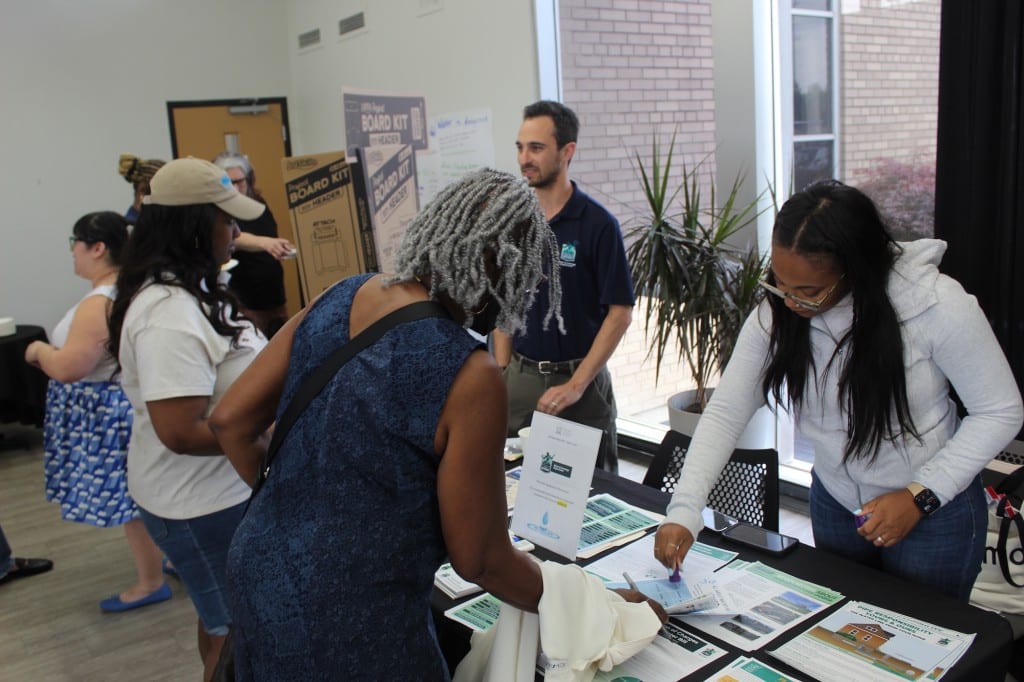
- Loretta Powell finds solace as a volunteer resident planner for the Detroit River Watershed Management Plan, a project aimed at improving water quality and addressing flood concerns.
- The Detroit River Watershed Management Plan, led by Marie Garcia, seeks to unify climate-resilient neighborhoods through green stormwater infrastructure and community collaboration.
- Detroit’s stormwater runoff management efforts are bolstered by the involvement of local residents, who bring creativity and enthusiasm to projects like rain gardens and urban farming.
Loretta Powell has difficulty wiping away the memory of the 2021 summer rainstorms from her mind. The sound of heavy rainfall and fire truck sirens woke her up in the middle of the night. Once the storm subsided, her basement was flooded, damaging her water heater and furnace.
“It was very scary for me,” Powell, who lives in Detroit’s East Canfield neighborhood, told Planet Detroit. “When it rains, sometimes I get really nervous because of what I went through.”
Flash forward to today. Powell says she gets some solace working as a volunteer resident planner for the Detroit River Watershed Management Plan. It’s a new project that organizers hope can improve the river’s water quality and help address resident concerns in flood-prone neighborhoods.
The plan was spotlighted at a town hall Saturday hosted by Eastside Community Network. The event brought together residents, public officials, and water justice advocates to share resources and discuss solutions around water unaffordability, flooding and basement backups.
Marie Garcia, a Wayne State University postdoctorate fellow, is the lead coordinator of the watershed management plan and was among the main organizers of Saturday’s event. The project is being funded by the Environmental Protection Agency’s Great Lakes Restoration Initiative and the Michigan Department of Environment, Great Lakes, and Energy (EGLE). The initiative will receive technical assistance from city, state, and federal agencies.

“The end goal is to improve water quality, but we’re also doing that by addressing flooding,” said Garcia. “There are things in this plan that may say we want to prioritize green space, or we want to add opportunities for recreation in different parts of the city where it’s feasible and where it can also help address water issues.”
The project is funded by EGLE and the EPA’s Great Lakes Restoration Initiative. Additional funding from the Erb Family Foundation supports the resident planners,
Detroit’s stormwater runoff flows into Lake St. Clair, the Detroit River, and the Rouge River. In extreme weather, the city’s 3,000 miles of sewer pipes can become overburdened, causing basement backups and flooding, as well as polluted waste to enter those bodies of water.
Garcia said there are as many as 11 different subwatersheds within city limits, but most of the city has been left off of management plans created by neighboring communities over the past several decades. A plan for the River Rouge Watershed was approved in 2012.
She added that the Detroit River Watershed Management Plan would cover those previously ignored areas, including the city’s east side, all of Hamtramck, and just over half of Highland Park. A watershed is the area of land that drains to a specific body of water, in this case, the Detroit River.
No state or federal agencies require watershed management plans, but they can be used to identify recommendations and best practices for key problems. She described the plan as a “recipe book” where individual residents or community organizations can pull different ideas and recommendations to advocate for certain policies or ordinances or start projects in their neighborhoods. Certain funding sources also require a watershed management plan.
As Detroit and Southeast Michigan prepare for heavier and more frequent rains due to climate change, the plan could also assist residents and city officials in acquiring grant funding or advocating for certain projects, such as rain gardens or wetlands, to mitigate flooding risks.

Powell created a rain garden in her yard in 2018. Although it didn’t completely deter stormwater flooding in her basement, it inspired her deeper interest in green stormwater projects, such as the Little Detroit Community Garden in her neighborhood.
West Village resident Colleen Ludwig is also a resident planner with the Detroit River Watershed Management Plan. She hopes the plan can help create a unified vision of climate-resilient neighborhoods.
“I’m always thinking about all the things that we could be doing to build land justice in our city,” Ludwig said. “This feels like there’s potential to make it a bigger effort. We’ve seen urban farming and native plant gardens piecemeal, but the city is so big and it needs more connectivity.”
So far, the Detroit River plan has leaned on the expertise and thinking of city residents like Powell and Ludwig. Of the 15 residents who are part of the Resident Watershed Planner group assisting Garcia, the majority live on the east side. Over the past few months, the cadre has learned about the city’s water system and green stormwater infrastructure and is preparing to conduct community outreach.
“The residents right now are seeing that the sky’s the limit,” Garcia said. “They’re very creative, and they’re very excited, not just to be involved, but that this is happening.”
She added: “This isn’t necessarily something that was known that was missing by a lot of residents. But now that they know, they understand and they see why it’s needed in everything that they’ve been learning in the workshops that we’ve been having.”
Garcia noted that a written plan document should be completed by the end of the year. Then, it will need to be approved by the EPA and EGLE.
Those interested in learning more about the Detroit River Watershed Management Plan can sign up here to receive an emailed newsletter or contact Marie Garcia at rmarie.garcia@wayne.edu.

